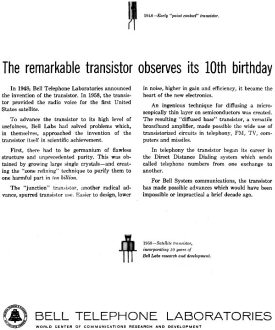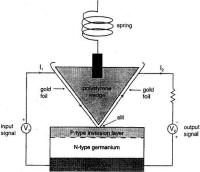|
June 1958 Radio-Electronics
 [Table of Contents] [Table of Contents]
Wax nostalgic about and learn from the history of early electronics.
See articles from Radio-Electronics,
published 1930-1988. All copyrights hereby acknowledged.
|
Just before Christmas in 1947,
Bell Labs' John Bardeen, Walter Brattain, and William Shockley announced their invention
of the first semiconductor device capable of producing positive signal amplification.
They dubbed it the "transistor" because it was a transconductance amplifier. In very
short order, the laboratory experiment consisting of a metallic point contact (a
piece of gold foil) interfaced with a slab of purified and doped germanium became
commercially available at a price that easily competed with a vacuum tube amplifier
when the cost of the socket and high voltage biasing transformers were factored
in. Transistors would not be able to entirely replace tubes for many decades, especially
for high power and high frequency applications, but as you can see today, the only
vacuum tube the average person will find anywhere is in an old computer or TV CRT
display or in an antique radio set sitting on someone's shelf.
The Remarkable Transistor Observes its 10th Birthday
- Bell Telephone Laboratories

Original ad in Radio-Electronics

Schematic of first transistor

1948-Early "point contact" transistor (left).
In 1948, Bell Telephone Laboratories announced the invention of the transistor.
In 1958, the transistor provided the radio voice for the first United States satellite.
To advance the transistor to its high level of usefulness, Bell Labs had solved
problems which, in themselves, approached the invention of the transistor itself
in scientific achievement.
First, there had to be germanium of flawless structure and unprecedented purity.
This was obtained by growing large single crystals - and creating the "zone refining"
technique to purify them to one harmful part in ten billion.
'The "junction" transistor, another radical advance, spurred transistor use.
Easier to design, lower in noise, higher in gain and efficiency, it became the heart
of the new electronics.
An ingenious technique for diffusing a microscopically thin layer on semiconductors
was created. The resulting "diffused base" transistor, a versatile broadband amplifier,
made possible the wide use of transistorized circuits in telephony, FM, TV, computers
and missiles.
In telephony the transistor began its career in the Direct Distance Dialing system
which sends called telephone numbers from one exchange to another.
For Bell System communications, the transistor has made possible advances which
would have been impossible or impractical a brief decade ago.

1958-Satellite transistor, incorporating 10 years
of Bell Labs research and development.

BELL TELEPHONE
LABORATORIES
WORLD CENTER OF COMMUNICATIONS RESEARCH AND DEVELOPMENT
Posted January 18, 2022
(updated from original post on 6/7/2014)
|














